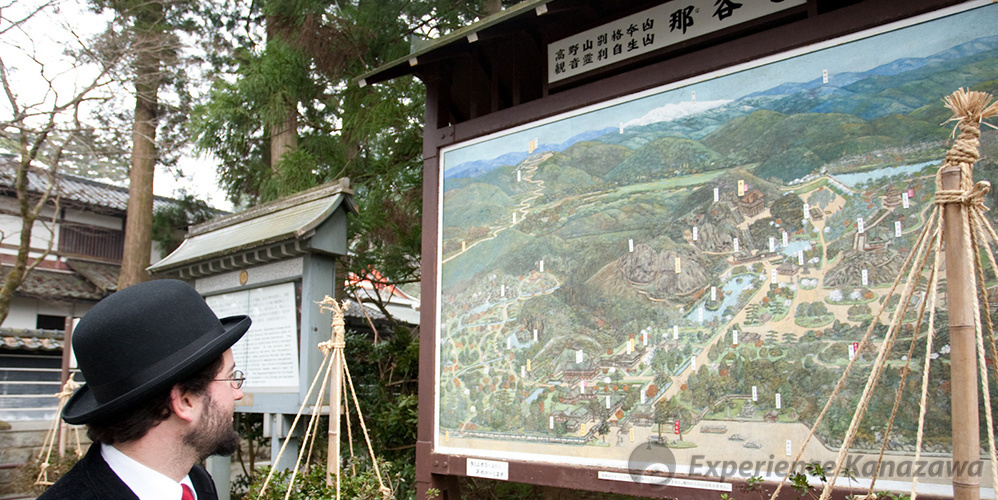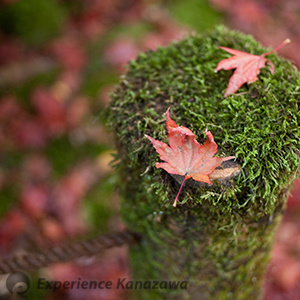Following Matsuo Bashô’s steps in Ishikawa


Bashô in Natadera Temple
The Natadera Temple holds an immemorial history. At the end of the 10th century, the retired Emperor Kazan, who is also said to have planted the pine tree sapling from which the area of Komatsu holds its name, baptized the temple with its actual name. By assembling the two characters of “Na” and “Ta”, he was referring to Nachi and Tanigumi, the first and last steps of the 33 temples of the west pilgrimage road. Natadera Temple was associated from the beginning with the feeling of quintessence. After many chronic destructions, during the warring states period, it owes its nowadays appearance to huge rebuilding works led in the 17th century by the feudal lord of the Kaga Province, Maeda Toshitsune.
Way back in time, it is said to have been founded by a semi-legendary Buddhist priest, named Taichô, evenly initiator of the Mount Hakusan worship in the 8th century. It was from the beginning associated with the worship of the thousand armed Kannon, the Buddhist mercy goddess still figured today by a monumental statue in the main temple building. Taichô is said to have carved a statue of Kannon and enshrined it inside the rocky caves of the neighbouring cliff. That is one of the main highlights of the area, for the rocks here present a striking appearance.
Whiter, whiter than
The stone of stone mountains
The autumnal wind
The white colour of the strangely shaped rocks now rules the landscape, offering a magnificent contrast with the reddening of the autumn foliage that can be seen from different points through the temple.
The white element is the key to the interpretation of Bashô’s dreamy visions. The poetic intention of this haiku is still largely debated today, however it is likely that he was referring both to the Buddhist heritage of the place and the natural element. The temple’s original name, after being founded by Taichô, mentioned both the rocky caves and the white colour of the cliff, through an animistic perspective (Jisshozan Iwayadera).


But this white colour is also referring to the Mount Hakusan (whose meaning in Japanese is precisely “white mountain”) as well as to the Taoist system of correspondences, in which the white colour symbolizes both the autumn season and the western lands.
Passed the stone where are inscribed Bashô’s verses, walking further through the vast park of the temple, takes the stroller drawing away from the cliff and its self-evident bond to human activities, what Matsuo Bashô calls “the misleading world”. Several buildings, including a three-storied pagoda and a bell tower, mark an obvious but gradual delimitation between two states of nature. The nature stylized through the gardening work inside, or left to fend for itself beyond. One can feel how this place was regularly subject to havoc during the feudal wars and abandoned before being rebuilt a few decades prior to Matsuo Bashô’s visit. This feeling of overwhelming nature and loneliness is very telling when, through the mountains, blow the strong winds that usually sweep Japanese western regions in the fall, whitening up the rocks in Natadera.Beyond its magnicent natural sceneries, few other temples express like Natadera, such atmospheres of mystery and unanswered questioning.
Kanazawa Area
Kenrokuenn Garden
Following Matsuo Bashô’s steps in Ishikawa - 1/6 [Introduction]
Following Matsuo Bashô’s steps in Ishikawa - 2/6 [Kanazawa]
Noto Area
Mitsukejima Island
Kaga Area
Following Matsuo Bashô’s steps in Ishikawa - 3/6 [Komatsu City]
Following Matsuo Bashô’s steps in Ishikawa - 4/6 [Natadera Temple]
Following Matsuo Bashô’s steps in Ishikawa - 5/6 [Yamanaka Onsen Town]
Following Matsuo Bashô’s steps in Ishikawa - 6/6 [Daishoji District]
Rosanjin in Yamashiro Onsen Town
Stroll Kanazawa in Rental Kimono - 1/2 [Kimono Rental]
Stroll Kanazawa in Rental Kimono - 2/2 [Kimono Stroll]
January
Enyukai: Geisha Party
February
Setsubun-Sai Festival
AUGUST
Issaki Hoh-Toh Matsuri
November
Enyukai: Geisha Party

